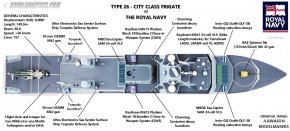One thing that stood out when reading that article is the weight of the Mission Bay Handling system and its supporting structure. My understanding is that elevated weight is the major problem that the Hunter designers are grappling with as the CEAFAR AESA radar has its electronics mounted directly on the back of the antennas which are mounted very high for obvious reasons and results in a heavy main mast. The SPY radar has its electronics positioned lower in the AWD’s with wave guides connecting up to the antennas. With a number of other heavy items mounted high (such as secondary guns, hanger winch for helicopter engine changes, CIWS systems, etc) you get an idea of the design problems. The British Type 26’s are planned to have some air defence missiles at the forward end of the mission bay but models of the Hunter class don’t show any in this location, possibly deleted because of excessive weight in such an elevated position had to go to offset the weight of the mast.
This indicates that the only way to increase the missile load on the Hunters would be with Mk57 VLS mounted along the periphery of the vessels in a much lower position - potentially along the sides of the flight deck as on the Zumwalt class. The fact that the stern of the Hunter class doesn’t taper in makes this more viable.
Mk57 VLS
As has been said before, we’ll have to wait and see what the experts do with the design.


